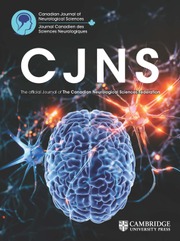Crossref Citations
This article has been cited by the following publications. This list is generated based on data provided by
Crossref.
Kramer, Andreas H.
2013.
Viral Encephalitis in the ICU.
Critical Care Clinics,
Vol. 29,
Issue. 3,
p.
621.
Gilboa, Tal
and
Gross‐Tsur, Varda
2013.
Epilepsy in Prader–Willi syndrome: experience of a national referral centre.
Developmental Medicine & Child Neurology,
Vol. 55,
Issue. 9,
p.
857.
Kramer, Andreas H.
and
Zygun, David A.
2013.
Declining mortality in neurocritical care patients: a cohort study in Southern Alberta over eleven years.
Canadian Journal of Anesthesia/Journal canadien d'anesthésie,
Vol. 60,
Issue. 10,
p.
966.
Claassen, Jan
Taccone, Fabio S.
Horn, Peter
Holtkamp, Martin
Stocchetti, Nino
and
Oddo, Mauro
2013.
Recommendations on the use of EEG monitoring in critically ill patients: consensus statement from the neurointensive care section of the ESICM.
Intensive Care Medicine,
Vol. 39,
Issue. 8,
p.
1337.
Khan, Omar I.
Azevedo, Christina J.
Hartshorn, Alendia L.
Montanye, Justin T.
Gonzalez, Juan C.
Natola, Mark A.
Surgenor, Stephen D.
Morse, Richard P.
Nordgren, Richard E.
Bujarski, Krzysztof A.
Holmes, Gregory L.
Jobst, Barbara C.
Scott, Rod C.
and
Thadani, Vijay M.
2014.
A comparison of continuous video‐EEG monitoring and 30‐minute EEG in an ICU.
Epileptic Disorders,
Vol. 16,
Issue. 4,
p.
439.
Claassen, Jan
and
Vespa, Paul
2014.
Electrophysiologic Monitoring in Acute Brain Injury.
Neurocritical Care,
Vol. 21,
Issue. S2,
p.
129.
Kramer, Andreas H.
and
Zygun, David A.
2014.
Neurocritical care.
Current Opinion in Critical Care,
Vol. 20,
Issue. 2,
p.
174.
Laccheo, Ikuko
Sonmezturk, Hasan
Bhatt, Amar B.
Tomycz, Luke
Shi, Yaping
Ringel, Marianna
DiCarlo, Gina
Harris, DeAngelo
Barwise, John
Abou-Khalil, Bassel
and
Haas, Kevin F.
2015.
Non-convulsive Status Epilepticus and Non-convulsive Seizures in Neurological ICU Patients.
Neurocritical Care,
Vol. 22,
Issue. 2,
p.
202.
Kramer, Andreas H.
and
Bleck, Thomas P.
2016.
Surgical Intensive Care Medicine.
p.
243.
Sutter, Raoul
2016.
Are We Prepared to Detect Subtle and Nonconvulsive Status Epilepticus in Critically Ill Patients?.
Journal of Clinical Neurophysiology,
Vol. 33,
Issue. 1,
p.
25.
Wang, Xuefeng
Zhang, Yuehua
and
Leung, Howan
2017.
Refractory Status Epilepticus.
p.
75.
Kim, J.A.
Rosenthal, E.S.
Biswal, S.
Zafar, S.
Shenoy, A.V.
O'Connor, K.L.
Bechek, S.C.
Valdery Moura, J.
Shafi, M.M.
Patel, A.B.
Cash, S.S.
and
Westover, M.B.
2017.
Epileptiform abnormalities predict delayed cerebral ischemia in subarachnoid hemorrhage.
Clinical Neurophysiology,
Vol. 128,
Issue. 6,
p.
1091.
Kramer, Andreas H.
and
Kromm, Julie
2019.
Quantitative Continuous EEG: Bridging the Gap Between the ICU Bedside and the EEG Interpreter.
Neurocritical Care,
Vol. 30,
Issue. 3,
p.
499.
Da Silva, Ivan
and
Bleck, Thomas P.
2021.
Cardiopulmonary Monitoring.
p.
337.
Kromm, Julie
Fiest, Kirsten M.
Alkhachroum, Ayham
Josephson, Colin
Kramer, Andreas
and
Jette, Nathalie
2021.
Structure and Outcomes of Educational Programs for Training Non-electroencephalographers in Performing and Screening Adult EEG: A Systematic Review.
Neurocritical Care,
Vol. 35,
Issue. 3,
p.
894.
Zawar, Ifrah
Briskin, Isaac
and
Hantus, Stephen
2022.
Risk factors that predict delayed seizure detection on continuous electroencephalogram (cEEG) in a large sample size of critically ill patients.
Epilepsia Open,
Vol. 7,
Issue. 1,
p.
131.
Alkhachroum, Ayham
Ganesan, Saptharishi Lalgudi
Koren, Johannes P.
Kromm, Julie
Massad, Nina
Reyes, Renz A.
Miller, Michael R.
Roh, David
Agarwal, Sachin
Park, Soojin
and
Claassen, Jan
2022.
Quantitative EEG-Based Seizure Estimation in Super-Refractory Status Epilepticus.
Neurocritical Care,
Vol. 36,
Issue. 3,
p.
897.
Alkhachroum, Ayham
Kromm, Julie
and
De Georgia, Michael A.
2022.
Big data and predictive analytics in neurocritical care.
Current Neurology and Neuroscience Reports,
Vol. 22,
Issue. 1,
p.
19.
Bencsik, Caralyn
Josephson, Colin
Soo, Andrea
Ainsworth, Craig
Savard, Martin
van Diepen, Sean
Kramer, Andreas
and
Kromm, Julie
2025.
The Evolving Role of Electroencephalography in Postarrest Care.
Canadian Journal of Neurological Sciences / Journal Canadien des Sciences Neurologiques,
Vol. 52,
Issue. 2,
p.
192.


